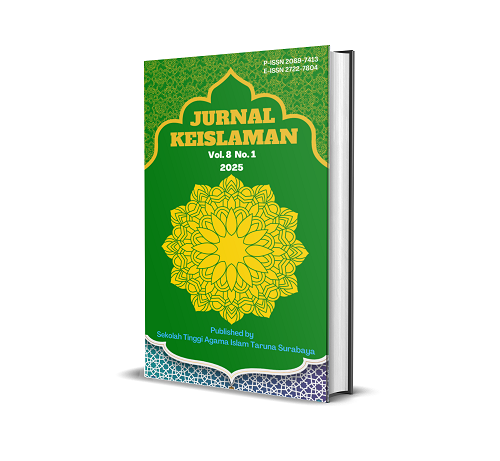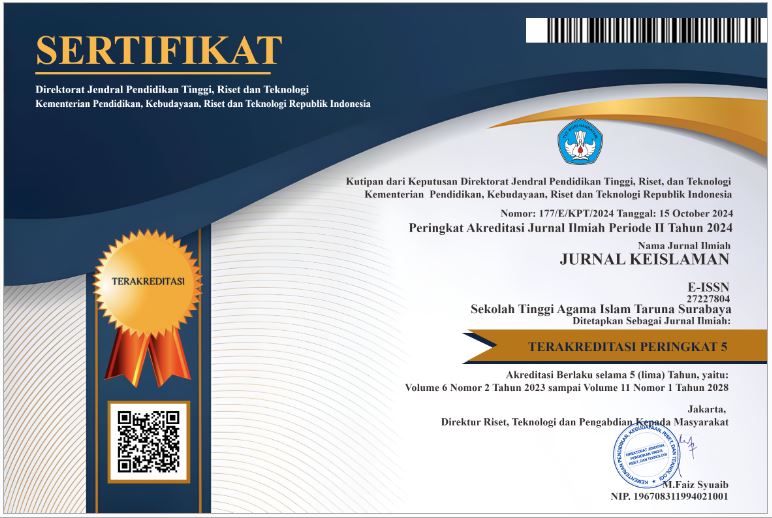Pengembangan Bahan Ajar Berbasis QR Code untuk Meningkatkan Minat Belajar Siswa pada Mata Pelajaran PAI di SMAN 15 Surabaya
DOI:
https://doi.org/10.54298/jk.v8i1.369Keywords:
Teaching Materials, QR Code, Interest in LearningAbstract
This research is a type of development research or Research and Development (R&D) with the ADDIE development model. Data collection techniques in this study were through questionnaires, interviews, and documentation. Data obtained from the questionnaire were analyzed descriptively qualitatively and quantitatively. The results of the study showed that the development of QR Code-based teaching materials was carried out through five stages, namely analysis, design, development, implementation, and evaluation. The results of the development of these teaching materials are suitable for use as teaching materials in class X in the PAI subject at SMAN 15 Surabaya. Student learning interest in the experimental class reached 87.26% with a very good category while the control class reached 81% with a very good category. So, the percentage of learning interest in the experimental class is greater than the control class. The development of QR Code-based teaching materials to increase student learning interest in the PAI subject at SMAN 15 Surabaya can be seen from the results of the unpaired sample t-test analysis through the SPSS version 26 application with a significance level of 0.05 obtained Sig. (2-tailed) of 0.000 (0.000 <0.05). So Ha is accepted and H0 is rejected, meaning that the development of QR Code-based teaching materials can increase students' interest in learning Islamic Religious Education subjects in class X at SMAN 15 Surabaya.
Downloads
References
Arifin, Moch Bahak Udin, and Nurdyansyah. Buku Ajar Metodologi Penelitian Pendidikan, 2018.
Athiyyaturrahmah, and Nurul Zainab. “Pengembangan Bahan Ajar Al-Qur’an Hadits Berbasis Digital Dalam Meningkatkan Minat Belajar Siswa.” Jurnal Pendidikan Indonesia : Nusantara 4, no. 1 (2024): 560–75. https://doi.org/10.36088/islamika.v6i2.4571.
Bariyah, Atik, Miftahul Jannah, and Hikmatu Ruwaida. “Peran Guru Dalam Meningkatkan Motivasi Belajar Siswa Sekolah Dasar.” Jurnal Basicedu 7, no. 1 (2023): 572–82. https://doi.org/10.31004/basicedu.v7i1.4604.
Cahyadi, Rahmat Arofah Hari. “Pengembangan Bahan Ajar Berbasis Addie Model.” Halaqa: Islamic Education Journal 3, no. 1 (2019): 35–42. https://doi.org/10.21070/halaqa.v3i1.2124.
Hakim, Lukman. “Transformasi Pendidikan Agama Islam : Strategi Dan Adaptasi Pada Era Revolusi Industri 4 . 0.” Jurnal Education and Development 9, no. 4 (2021): 760–66.
Harahap, Muhammad Syahril, Sinar Depi Harahap, Sari Wahyuni Rozi Nasution, Dedes Asriani Siregar, and Elisa Karolina. “Pengembangan Bahan Ajar Matematika Diskrit Berbasis Digital Qr-Code Untuk Meningkatkan Efektivitas Belajar Mahasiswa Pendidikan Matematika Institut Pendidikan Tapanuli Selatan.” JURNAL MathEdu( Mathematic Education Journal0 6, no. 1 (2023): 29–39. https://journal.ipts.ac.id/index.php/MathEdu/article/view/3863.
Johnson, Aaron W., Magel P. Su, Max W. Blackburn, and Cynthia J. Finelli. “Instructor Use of a Flexible Classroom to Facilitate Active Learning in Undergraduate Engineering Courses.” European Journal of Engineering Education 46, no. 4 (2021): 618–35. https://doi.org/10.1080/03043797.2020.1865878.
Nasruddin, Nasruddin. “Pengembangan Bahan Ajar Sejarah Daerah Bima Berbantu Quick Response Codes Kelas X Sma Negeri 1 Woha.” JISIP (Jurnal Ilmu Sosial Dan Pendidikan) 4, no. 3 (2020): 26–31. https://doi.org/10.36312/jisip.v4i3.1142.
Ratnasari, Eka FR, Sucipto, and Kusmiyati. “Pengembangan Media E-Book Berbasis Multimedia Interaktif Dengan QR Code Untuk Meningkatkan Minat Belajar Dan Kemampuan Berfikir Kritis Pada Peserta Didik Tingkat Sekolah Dasar.” Jurnal Ilmiah Pendidikan Dasar 09, no. September (2024).
Sholeh, Abdul Chalim. “Pengembangan Media Flashcard Berbasis QR Code Pada Materi Energi Dan Pengaruhnya Untuk Meningkatkan Hasil Belajar Siswa Kelas III MI Cemorokandang,” 2023, 1–14.
Downloads
Published
How to Cite
Issue
Section
License
Copyright (c) 2025 Faizah Nurrahma, Ah. Zakki Fuad, Sutikno

This work is licensed under a Creative Commons Attribution-ShareAlike 4.0 International License.
Authors who publish with this journal agree to the following terms:
- Authors retain copyright and grant the journal right of first publication with the work simultaneously licensed under a Creative Commons Attribution-ShareAlike 4.0 that allows others to share the work with an acknowledgement of the work's authorship and initial publication in this journal.
- Authors are able to enter into separate, additional contractual arrangements for the non-exclusive distribution of the journal's published version of the work (e.g., post it to an institutional repository or publish it in a book), with an acknowledgement of its initial publication in this journal.
- Authors are permitted and encouraged to post their work online (e.g., in institutional repositories or on their website) prior to and during the submission process, as it can lead to productive exchanges, as well as earlier and greater citation of published work (See The Effect of Open Access).


















